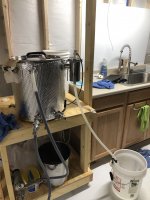So I'm building a new house and I have a Brew Room in the basement. It is on an outside wall and I can easily install a vent in the wall to vent the steam via a hood and fan and also pull make up air back in. However, after reading through this thread, I'm wondering if this would not be a better option. Any recommendations on whether to go with the condenser or the traditional vent hood setup? FYI, I do BIAB electric brewing with SS Brewtech pots. Assume there are no issues fitting the condenser to the SS Brewtech pots?
I can not speak about ventilation system, however, i can give some feed back on brewing in my basement with a Steam Slayer. Little history, I am a EBIAB(10 gal Spike Kettle).I just had my home built (started construction) 3 years ago. Once I moved in, i had to do some upgrades. I ran water lines (hot and cold)so that I can have a sink, (bought some cabinets, and a kitchen sink, counter top) for my drain, I have it running to a sump pump. Most of everything is gray water, and which i used to through in my yard when i brewed outside. (sump pump is maybe 7 feet from my sink. I do have access to a drain that goes to my septic, but that would take a lot more work, and expense. I had a 30 amp breaker and outlet installed. My basement is completely open (1600 SQ FT).
With the steam slayer, it is very quite. The set up was very easy to do. I do 5 gal batches, so I end up going through about 6-7 gals of water during my 60 min boil.I use 5 gal buckets to catch the water coming from the Steam Slyer. I swap out buckets about half way through, dump the water in my sink, add cold water to cool the water down (don't want to damage sump pump from the hot water). I do have a slight smell, however it seems to be more of a brewery smell than anything. Not sure if you can get away from that. As far as heat coming from it, The temp will raise up in the basement about 1 degree. Humidity rises about 2%. As far as off flavors or issues with DMS, I have not noticed any myself. It may because of my pallet, who knows.
It did take me a few attempts to dial in my system, just because now, i am boiling with the lid on, and not boiling off as much. in turn, I believe that I am also able to lowered my percent on my element, because it is keeping the heat more inside (lower electric bill), but I can not say, because When I started Brewing inside, I brewed with the steam slayer, so I have not comparison. When I brewed outside, i used Propane.
I hope this helps. With any system, look at your needs, and wants. Either system has its + and its -.


























![Craft A Brew - Safale S-04 Dry Yeast - Fermentis - English Ale Dry Yeast - For English and American Ales and Hard Apple Ciders - Ingredients for Home Brewing - Beer Making Supplies - [1 Pack]](https://m.media-amazon.com/images/I/41fVGNh6JfL._SL500_.jpg)




































